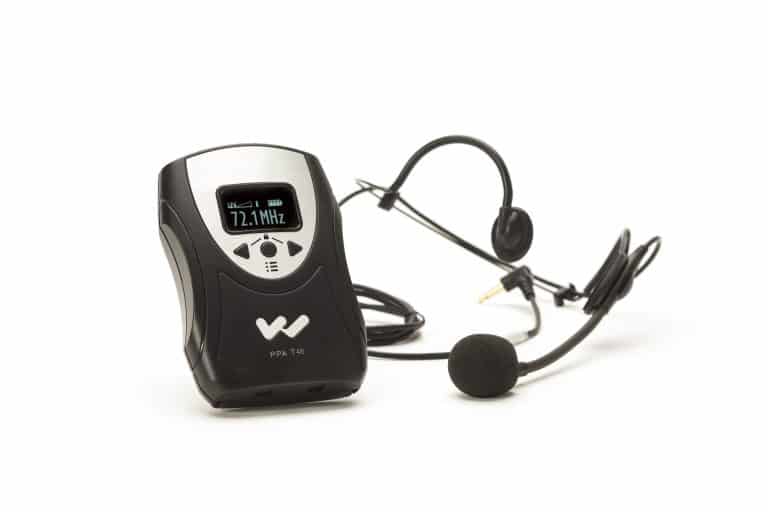Simultaneous interpretation equipment in Laval


Translation and Interpretation Systems and equipment in Laval

This article is an explanation of the simultaneous interpretation equipment available to end users in Laval.
What is simultaneous interpretation?
First and foremost, simultaneous interpretation is an oral process used to translate a speech. Generally speaking, simultaneous interpretation is when the interpreter has to listen to the speaker and translate at the same time! It should be noted that there is always what is called a “time lag”. Simultaneous interpreting is almost always done in teams of two or three interpreters. In this team, one interprets and the other serves as a support in case of difficulty. The two often exchange roles every 1⁄2 hour, sometimes even more. The interpreters meet in an interpreting room or booth and will have a microphone. All participants, meanwhile, will have headphones, but also earbuds. This discipline is ideal for conferences, assemblies, conventions, meetings.
Brief history of simultaneous interpretation equipment
The idea of designing simultaneous interpretation equipment originated in the 1920s. The United Nations can be proud of its discovery. The forerunners of this interpretation system were Edward Filene and Alan Gordon Finlay. They named this work “the Filene-Finlay simultaneous translator”! The translation of the texts is already done before the event starts, then the reading is done.
Nobody believed that simultaneous interpreting could be done live, except the inventors. After the Second World War, interpreting equipment was seen at the Nuremberg trials. Today, it is practiced all over the world, including in Laval: it is a remarkable invention.
Simultaneous interpretation equipment today
Simultaneous interpretation is the most widely used concept in conferences today. In this case, there are specialized manufacturers of simultaneous interpreting equipment. Not just any market can provide reliable and efficient equipment.
In order to get good tools, it is better to go to the companies that have a great knowledge in this field. The companies that are in the audiovisual business are not able to deliver the best equipment. One can also choose to rent the equipment from the same firm. By doing so, the interpreters avoid the different sequels that could occur.

What configurations of simultaneous interpretation equipment are there?
There are three configurations for simultaneous interpretation:
Permanent installations
This can be seen in large conferences, such as United Nations conferences. This system is already installed in the conference room and is permanently integrated. There are small, soundproof booths with windows. The interpreters work in these booths and they also provide a lot of comfort. They are very practical, but on the other hand, the problem lies in their mobility.
Portable/mobile configuration
The portable or mobile configuration differs from the permanent configuration in that it is not immutable. In the conference room, there is no fixed setup: booths must be set up before the event. Portable interpreter kits are very practical because of this mobility, but the managers have to fix them first. The booths must also meet certain criteria to ensure that the work runs smoothly.
It is essential that there is space for two interpreters per language. In other situations, such as large conferences, the booth may have three interpreters per language. Note that gatherings of this size often involve more than two interpreters. As with the permanent booths, the portable booths are equipped with fans and lighting equipment.
Whispering Equipment
Whispering equipment is mobile, consisting of a wireless receiver that is also portable. In the set, there is also a wireless transmitter: the interpreters can move around. In fact, they can move around a lot thanks to the mobility of the equipment, but this design is not very practical in a standard conference.

What equipment is inside the simultaneous interpretation booth?
Simultaneous Interpreting Console
If there is no booth available, interpreters may have to use a tour guide case. This is a set of simultaneous equipment system receivers that interpreters use. It is an interpreting console: it has headsets for the listeners and a microphone for the interpreter. The interpreter will be in the same room as the listeners, so there must be many headsets and microphones. Both the headphones and the microphones must be well adjusted in order to switch from one language to another.
The interpreter’s headset
First of all, it is necessary that each interpreter has his or her own headset to avoid any confusion. Only the sound technician can provide them with this device after it has been checked. The most efficient headsets are produced by companies specialized in simultaneous interpretation. For some interpreters, they have headsets that they can take with them wherever they go. These headsets must be designed so that the interpreter can hear the original speech.
Microphones
- Interpreter’s microphones are divided into three categories: the microphone built into a headset, the microphone built into a console, and a stand-alone table microphone.
- The microphone fixed in a helmet: The microphone is permanently placed in the helmet. It is equipped with a component that can be flexed easily: a flexible arm. For the record, this is the best choice of headset, as it is very practical for an interpreter. Even if the interpreter makes a movement with his head, there will be no distance between his mouth and the microphone.
- The microphone fixed in a gizmo: This is not very recommended compared to the first microphone option. The microphone connector is located in the upper part of the interpreting console. However, many interpreters still use this version of the conference microphone.
- The stand-alone tabletop microphone: This microphone and the console are connected by a cable. These microphones are placed separately on a control desk. On the other hand, the heat from the microphone could be a hazard to the interpreters. However, headsets connected to microphones are the most reliable and secure.

